London, England
Veluwe, Netherlands
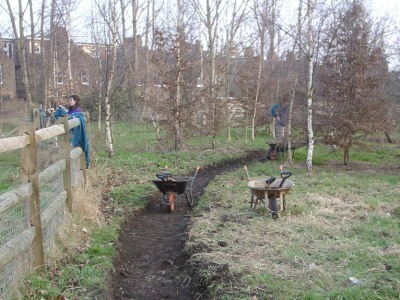
Winding foot path built in a small nature reserve. Final length 135 m long, 1 m wide, facing south in the photo, courtesy of Pat Robinson.
This photo shows the path after the woodchips were dug out in preparation for the hoggin [1] being laid. For more details see below.
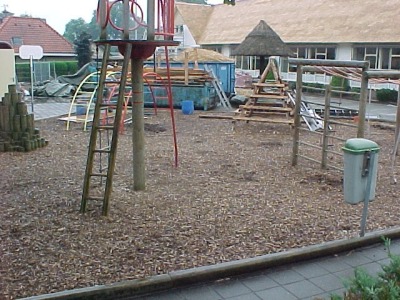
Primary school playgrounds, total area about 325 m2, facing south. The photo, taken by Bert van Geel, shows the larger one, 225 m2.
Lowest recorded winter temperature: -20o C.
However while the path was being dug quite a lot of household rubble was found plus some stag beetle larvae as well, the latter were relocated nearby. It was excavated to a depth of 15-20 cm, unlined, then filled with fresh hardwood chips.
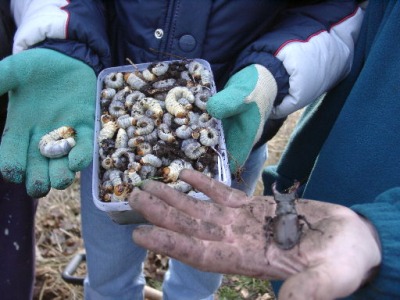
When the path was extended some larvae and adult stag beetles were found, which were relocated.
In early 2005 the woodchips had to be removed in order to make a more durable path, for which money had become available. See top photo.
In the process over 750 stag beetle larvae, a few live stag beetle imagos, and some sawfly larvae. See a sample above. Photo courtesy of Pat Robinson.[2]
All the larvae were relocated to an area of woodchip and logs within the nature reserve, see photo below.
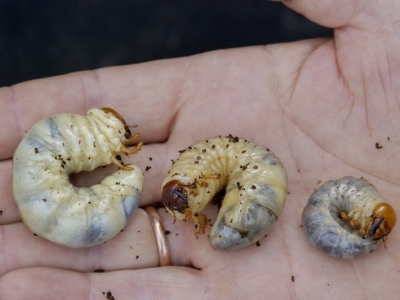
In July 2004 9 large stag beetle larvae, 200 rhinoceros beetle larvae, and one dead male stag beetle imago, were found in a short time just round the edges of one playground.
The photo, taken by Bert van Geel, shows, two stag beetle larvae and one rhinoceros beetle larva in the middle. [3]
Subsequent monitoring of these woodchip beds:
In 2006 only rhinoceros beetle larvae were found, no stag beetle larvae at all (John T. Smit, pers. com).
In September 2007, 263 rhinoceros beetle larvae and one L3 stag beetle larva were found by Paul Hendriks and Maria Fremlin.
People walked on the path regularly without apparent damage to the larvae. The larvae could easily pupate in the soil at the level of their choice.
Stag beetles were spotted in the area during the summer 2005.
Children trampled on the woodchips regularly and it seems to have made no difference.
Stag beetle and rhinoceros larvae seem to be resilient, and adaptable. They have had to pupate above the membrane, and seem to have survived the cold winters.
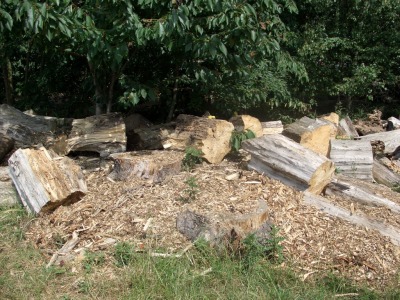
Experimental artificial stag beetle habitat created with a high ratio woodchips-to-logs.
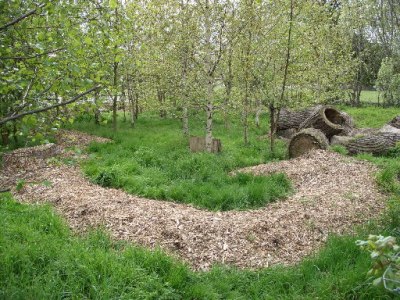
Another experimental habitat, this one with an even higher ratio woodchips-to-logs. Photos courtesy of Pat Robinson.
In July 17 2008 one L3 stag beetle (Lucanus cervus) larva, and several imago lesser stag beetles (Dorcus parallelipipedus) were found by Maria Fremlin.
Possibly the main reasons were (i) they rot very quickly, and (ii) they act as a very good mulch, thus conserving the moisture, both being very important factors for a successful nesting habitat.
Because of these experiences, in very different situations but yet so similar, there is probably great future in the role of woodchips for maintaining, and possibly increasing the population, and very gradually restoring the range of stag beetles. [4]
Therefore future artificial nests could be built, in known stag beetle areas, with these findings in mind. All that needs to be done is to considerably increase the ratio woodchips-to-logs, see left photo.
Maintenance is very important, all artificial nesting habitats benefit from being topped up regularly with woodchips. It is sometimes very difficult to strike a good balance with artificial habitats; for instance, note that on the photos above there are logs lying on the surface, not buried. Logs like that could easily dry up if not topped up. In the original pyramid design the logs are buried to a good 50 cm, at least, so that down below they do stay moist. That way perhaps there is not such a strong need for mulching with woodchips. [4]
However, if artificial nests are built outside stag beetle areas, then the results might be quite different; stag beetles are a “stay-at-home” kind of beetle. [4]